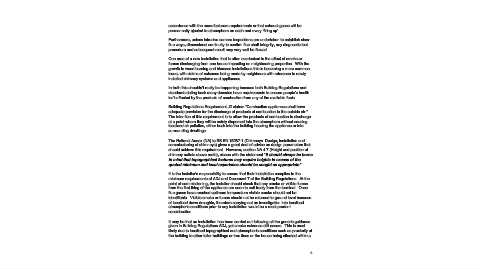Page 55 - Domestic Smoke Nuisance and Emissions Final_Neat
P. 55
accordance with the manufacturers requirements or that exhaust gases will be
permanently ejected to atmosphere on each and every ‘firing up’.
Furthermore, unless intrusive camera inspections are undertaken to establish clear
flue ways, dimensional continuity to confirm flue shaft integrity, any diagnostic test
procedure and subsequent result may very well be flawed.
One area of a new installation that is often overlooked is the effect of smoke or
fumes discharging from one house impacting on neighbouring properties. With the
growth in wood burning and biomass installations this is becoming a more common
issue, with claims of nuisance being made by neighbours with reference to newly
installed chimney systems and appliances.
In truth this shouldn’t really be happening because both Building Regulations and
standards dating back many decades have requirements to ensure people’s health
isn’t affected by the products of combustion from any of the available fuels.
Building Regulations Requirement J2 states: “Combustion appliances shall have
adequate provision for the discharge of products of combustion to the outside air.”
The intention of this requirement is to allow the products of combustion to discharge
at a point where they will be safely dispersed into the atmosphere without causing
localised air pollution, either back into the building housing the appliance or into
surrounding dwellings.
The National Annex (NA) to BS EN 15287-1 (Chimneys. Design, installation and
commissioning of chimneys) gives a great deal of advice on design parameters that
should achieve this requirement. However, section NA.4.7 (Height and position of
chimney outlets above roofs), closes with the statement “It should always be borne
in mind that topographical features may require heights in excess of the
quoted minimum and local experience should be sought as appropriate.”
It is the installer’s responsibility to ensure that their installation complies to the
minimum requirements of ADJ and Document 7 of the Building Regulations. At the
point of commissioning, the installer should check that any smoke or visible fumes
from the first firing of the appliance are seen to exit freely from the terminal. Once
flue gases have reached optimum temperature visible smoke should not be
identifiable. Visible smoke or fumes should not be returned to ground level because
of localised down draughts, therefore carrying out an investigation into localised
atmospheric conditions prior to any installation would be a most prudent
consideration.
It may be that an installation has been carried out following all the generic guidance
given in Building Regulations ADJ, yet smoke nuisance still occurs. This is most
likely due to localised topographical and atmospheric conditions such as proximity of
the building to other taller buildings or tree lines or the house being situated within a
3

